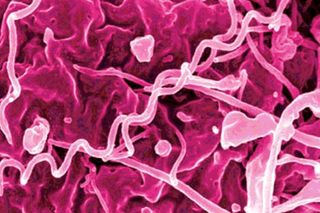
Everything You Need to Know About Syphilis
It’s been around since the 15th century.

Syphilis is a sexually transmitted infection (STI) with a long, stigma-filled history. While modern antibiotics have done much to control infection, in recent years, the number of reported cases in India has risen. Here are the basics on syphilis, and why it’s making a comeback.
What is syphilis?
Syphilis is a sexually transmitted infection caused by the Treponema pallidum bacterium.
How is syphilis transmitted?
Syphilis is transmitted via vaginal, anal, or oral intercourse. It is most contagious via contact with a sore called a chancre, which appears during the infection’s early stages (though the infection can be transmitted at any of the first three stages of the disease’s progression). These chancres are not always visible (while chancres may appear on the skin around the genitals or the mouth, they may also be present inside the vagina, around the anus, inside the rectum, or inside the mouth) or may be mistaken for pimples or a rash. Syphilis is also highly contagious through contact with the rash that characterizes the second stage of the infection.
Pregnant women with syphilis can transmit the STI to their baby. While women can be treated for the infection while still pregnant, the newborn would require its own course of treatment, too.
How prevalent is it? Is there a way to avoid it?
The exact prevalence of syphilis is difficult to determine in India. Broadly, India records 30 million new STI diagnoses each year (and likely many more infections go unreported), but the percent that are syphilis is not known. That said, experts say it is a common infection. Per a five-year study on syphilis prevalence in India, published in 2012: “…though viral STDs are on the rise, syphilis and herpes genitalis still remain the most common STIs.” Reports as recent as 2017, the prevalence of syphilis has increased across the country.
It is also a fairly common STI around the world. Per India’s National Health Portal, the “WHO estimates that 500 million new cases of one of four curable STIs (chlamydia, gonorrhoea, syphilis and trichomoniasis) occur each year worldwide.”
Syphilis prevention is similar to prevention of most other STIs. Condoms and dental dams are the best way to keep from contracting syphilis, though they are not foolproof, especially if a chancre is located outside the genital area.
What are the symptoms of syphilis?
This STI is known as “the great pretender,” as the signs of syphilis often mimic other, less serious infections (like, say, the flu) and often go unnoticed. But the disease follows a distinct progression, with the same signs and symptoms of syphilis for men and women (barring differences in where syphilis sores show up, given differences in anatomy).
Syphilis usually presents in four stages. In the first stage, one or more small, painless sores called chancres may appear around the mouth, anus, rectum, vagina or penis (or elsewhere on the body, depending on where and how the infected person was first exposed). These sores will heal on their own, without treatment, but that doesn’t mean the infection has healed. The development of chancres usually occurs anywhere from 10 to 90 days post-intercourse with an infected person (21 days is the common average).
If untreated, syphilis progresses to the second stage, which can (but may not always) include signs like: a reddish-brown rash on the extremities, especially the palms and soles of the feet, hair loss and general flu-feeling (fever, body aches, swollen lymph nodes and fatigue). These symptoms, too, will resolve on their own, but that doesn’t mean the infection has healed.
Instead, the bacteria enters the third, or “latent” phase: when there are no obvious symptoms of the disease, but the infection is going to work internally, damaging the circulatory, nervous and skeletal systems. Some effects of untreated syphilis may also damage fertility. This phase can last for years, if untreated, and will ultimately lead to the last or “late” stage of syphilis, potentially characterized by cardiovascular problems, poor muscle control, numbness, poor vision, dementia and, eventually, death.
How do you get diagnosed?
A simple blood test can diagnose an infection. In the case of untreated syphilis that reaches the third or fourth stage, when internal systems may be affected, a spinal fluid sample may be required.
The best route is to get tested for all possible STIs soon after having sex with a new partner, or as soon as you suspect a possible syphilis infection.
What is the treatment for syphilis?
Syphilis, when untreated, can be very serious and even deadly, long-term. But the good news is, in the early stages it’s highly treatable with antibiotics. A doctor should advise on which antibiotic to take; while penicillin is the preferred treatment (and only recommended treatment for pregnant women), roughly 10 in 100 people are allergic to the drug, and a different antibiotic or a sensitization regimen may be required.
Treatment for syphilis can prompt a Jarisch-Herxheimer reaction, which is characterized by sudden flu-like symptoms (aches, fever, nausea). This reaction is caused by toxins released when the Treponema pallidum bacteria die off, and it typically only lasts about 24 hours.
Depending on how advanced the infection is, a doctor may require periodic blood tests to make sure you’re responding to the antibiotic treatment.
Can syphilis be cured?
Is there a cure for syphilis? Yes, and especially when the infection is caught in the first two stages. In the later, latent stages, the infection can still be cured, but any internal damage it has done is permanent. Until a doctor pronounces you cured and the treatment complete, avoid having sex, as you might still be able to pass on the infection.
Even once cured, however, it’s still possible to contract syphilis again; exposure to the disease once does not prompt immunity to it going forward.
Anything else I should know?
The chancres that characterize syphilis in the first stage can make it easier to contract another STI, like HIV, via the broken skin.
People have been getting syphilis for centuries; just get an STI test soon after having sex with a new partner, or as soon as you notice syphilis symptoms. Better to be diagnosed and treated, than to live with, suffer from, and spread the disease.
This is part of our series on sexually transmitted infections.
Related


The Super Common, Mostly Treatable Women’s Health Problem No One Talks About
